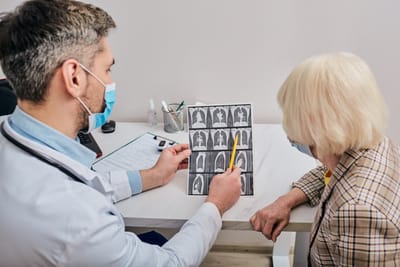Lung Cancer
Prevention is Key... Stop Smoking Now


Risk factors for lung cancer include smoking, exposure to secondhand smoke, exposure to radon, and exposure to certain chemicals and pollutants. People who have a family history of lung cancer or who have a history of lung disease may also be at higher risk.
Symptoms of lung cancer can vary depending on the stage and type of cancer, but may include persistent coughing, chest pain, shortness of breath, fatigue, and weight loss.
Diagnosis of lung cancer usually involves a combination of imaging tests, such as X-rays and CT scans, as well as biopsy to obtain a sample of the lung tissue for examination under a microscope.
Treatment options for lung cancer depend on the stage and type of cancer, as well as the individual’s overall health. Surgery, chemotherapy, radiation therapy, and targeted therapy are all possible treatment options. In some cases, a combination of these treatments may be used.
Surgery is often used for early-stage lung cancer, while chemotherapy and radiation therapy are typically used for more advanced stages. Targeted therapy may be used for some types of lung cancer that have specific genetic mutations.
Prevention of lung cancer involves avoiding exposure to risk factors such as smoking and radon, as well as maintaining a healthy lifestyle with a balanced diet and regular exercise.
In conclusion, lung cancer is a serious and often deadly disease, but early diagnosis and treatment can improve outcomes. If you have any concerns about your risk for lung cancer or if you are experiencing symptoms, it is important to talk to your doctor and book an appointment with Dr Aldik.
Case Study
Mrs. S is a 70-year-old grandmother who enjoys spending time with her family and gardening. Many years ago, she used to smoke, but she gave it up a long time back.
She has generally been in good health.One day, during a routine health check, her doctor noticed a small shadow on her chest X-ray. Mrs. S felt well and had no symptoms, but because of her past smoking history, the doctors wanted to be extra careful.She was quickly referred to Dr. Aldik who arranged more tests:
The results showed something important: Mrs. S had an early stage of lung cancer. The good news was that it had been found early, before it could spread. This meant it could be treated successfully with surgery. Mrs. S had an operation to remove the small cancer, and she recovered well. She didn’t need chemotherapy or radiotherapy afterwards.
Today, Mrs. S is back to enjoying her garden and her family. Her follow-up checks have been clear, and she is living life to the fullest.
What we can learn from her story:Lung cancer doesn’t always cause symptoms in the early stages. Routine checks and prompt investigations can make all the difference. Finding it early gave Mrs. S the best chance of a cure — and that’s exactly what happened.
She has generally been in good health.One day, during a routine health check, her doctor noticed a small shadow on her chest X-ray. Mrs. S felt well and had no symptoms, but because of her past smoking history, the doctors wanted to be extra careful.She was quickly referred to Dr. Aldik who arranged more tests:
- A CT scan to get a clear picture of her lungs.
- A PET scan to check if anything was active or spreading.
- An EBUS test, where doctors looked inside her airways with a small camera and took a sample.
The results showed something important: Mrs. S had an early stage of lung cancer. The good news was that it had been found early, before it could spread. This meant it could be treated successfully with surgery. Mrs. S had an operation to remove the small cancer, and she recovered well. She didn’t need chemotherapy or radiotherapy afterwards.
Today, Mrs. S is back to enjoying her garden and her family. Her follow-up checks have been clear, and she is living life to the fullest.
What we can learn from her story:Lung cancer doesn’t always cause symptoms in the early stages. Routine checks and prompt investigations can make all the difference. Finding it early gave Mrs. S the best chance of a cure — and that’s exactly what happened.